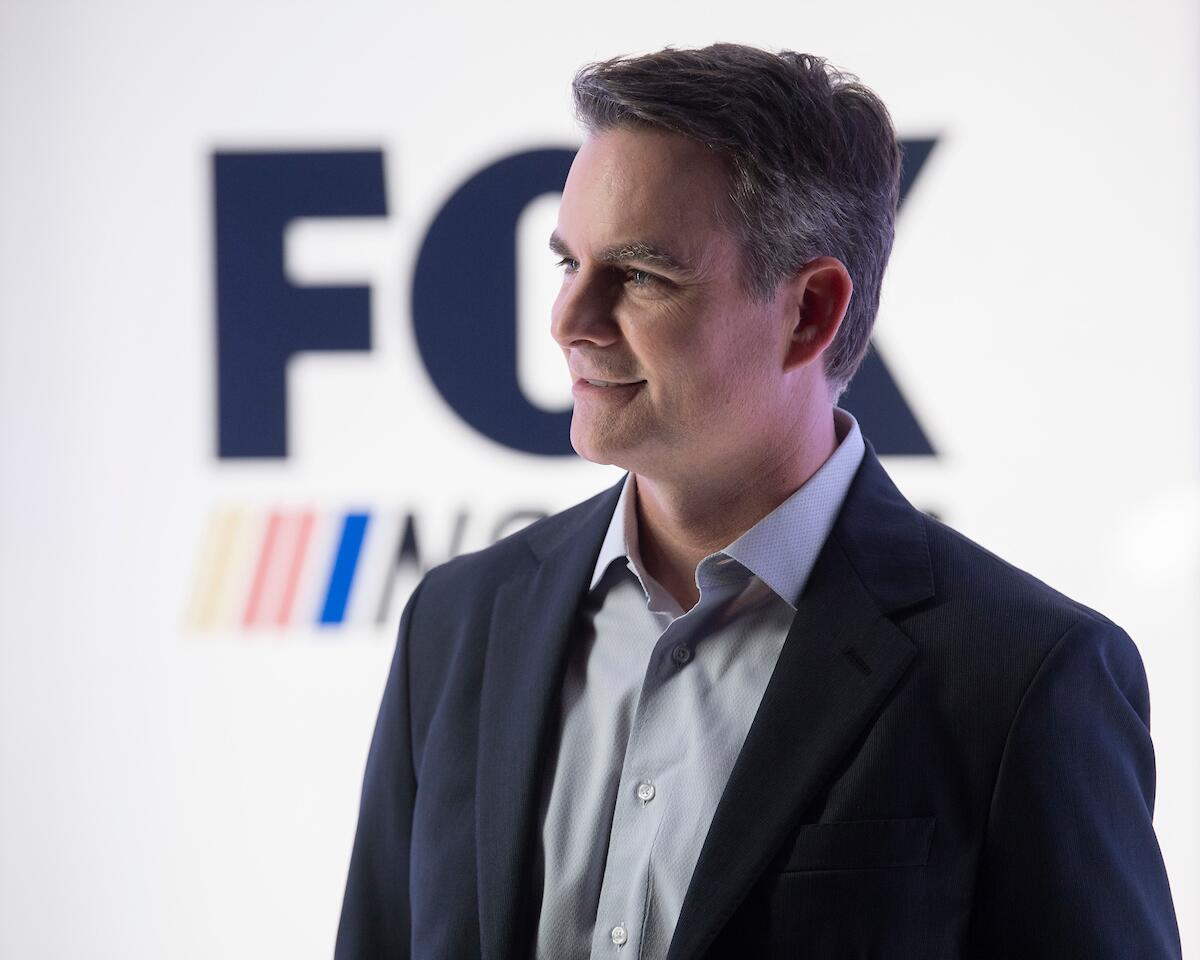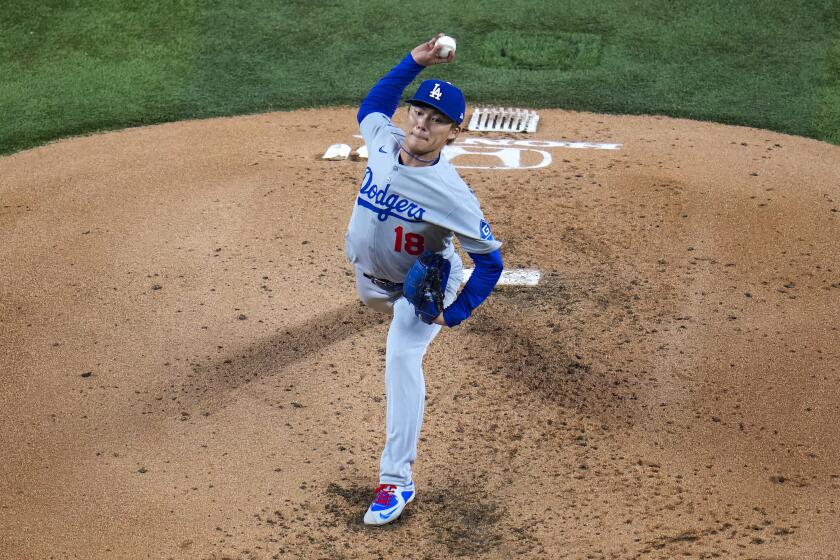For Jeff Gordon, broadcasting offers plenty of familiar NASCAR thrills
- Share via
Jeff Gordon was ready for the final lap of the Daytona 500 on Sunday.
After a 25-year NASCAR career that included four NASCAR Cup Series championships, the Hall of Famer knew to expect a crash once the white flag came out for the race’s final lap.
“You know that leader, no matter who it is, is going to try to do their best to protect that position … and you know everybody behind is doing their best to try to pass,” he said. “A lot of times, those agendas collide.”
He was correct. Literally.
Entering the final turn, leader Joey Logano was bumped from behind by Brad Keselowski, setting into motion a fiery multiple-car wreck from which Michael McDowell emerged to win the race.
The hard part for Gordon, now five years removed from his last NASCAR race and entering his sixth season as an analyst on Fox Sports’ broadcast team, was making a split-second analysis of the carnage in front of him.

Highlights from the Daytona 500 on Sunday.
Cars and debris were strewn across the track. Since the caution flag had come out on the last-lap crash, the winner wasn’t initially clear. Up in the booth, Gordon and long-time play-by-play broadcaster Mike Joy were navigating it all alongside new analyst Clint Bowyer, the first Cup Series race in which the trio had worked together.
“There’s a lot going through your mind,” Gordon said afterward. “That was pretty difficult to handle.”
Difficult, but also exciting — the latest example of how broadcasting has helped fill the void of Gordon’s retirement from racing.
There’s the team aspect, exchanging crew chiefs and pit crews for producers and directors. There’s a preparation process, a meticulous routine of studying tracks and gathering information that mirrors his old regimen as a driver. There’s also a competitive pressure, with the red light of a live camera replacing the frantic wave of a checkered flag.
“How you fulfill the competition and the adrenaline and excitement around driving, a lot of drivers I’ve talked to have struggled with that,” Gordon said. “To me, moving into the broadcast booth checked off some of those boxes. A live broadcast, your heart’s pumping.”
Television has long been a central thread in Gordon’s racing career. As a kid, he would watch “Thursday Night Thunder” races on ESPN. The late racing broadcaster Larry Nuber helped him make some of his first connections in the NASCAR world.
Gordon understood early the power TV played in a sport bringing weekly races to a national audience. Once he became established in the Cup Series, he would watch broadcasts of NASCAR’s other circuits and “just start running through what I would say, how I would have covered a crash, or how I would analyze a pass.”
“You do that enough times,” he added, “you go, ‘I wonder if this would be something that I could do one day?’”
Gordon, who holds an ownership stake in the Hendrick Motorsports team he drove for during his career, began seriously considering TV when back problems convinced him it was time to step out of the car. He reached out to Fox Sports CEO Eric Shanks about the idea, and joined the network’s broadcast booth — which then included Darrell Waltrip — for the 2016 season.
“He was definitely not your typical cookie-cutter NASCAR broadcaster,” Shanks said. “He had been very technical … and on the flip side, he’s Jeff Gordon. He’s hosted ‘Saturday Night Live.’ ”
Echoed Fox executive vice president Brad Zager on what made Gordon a natural fit for the booth: “Credibility and authenticity. … That’s what people gravitate toward.”
“I’m anything but retired. I’m [almost] 50 years old. I love what I’m doing.”
— Jeff Gordon
When Gordon covered his first Daytona, “my heart was pounding out of my chest like I was making a qualifying lap or something,” he said. Nonetheless, he quickly picked up the key to a good show: Don’t “empty out the bucket” of stories or nuggets of information too early in a race; how to seamlessly move into graphic cues and commercial breaks; and realizing that sometimes less analysis can do more for the viewer.
“That’s maybe the only thing that’s unnatural for me,” he said, “is just take that breath in, let it breathe and let the race play out, not always be trying to add something.”
Little else about the broadcasting process, however, felt foreign.
“It’s a great reminder to you of what you like the most about racing,” he said. “When I was racing, you always think it’s the driving, it’s the passing, it’s the winning” that you like most. “But it’s really the interaction with your team and sharing those moments with them that really matters. And that’s what I love about the broadcasting side of it. It’s the same thing, it’s the personalities and the relationships that get built. That’s the fun part of it, when you guys are brainstorming to come up with an idea that plays out on a live broadcast.”
Now, Gordon is something of a veteran in the booth. Joy called Gordon “easily” one of the top three analysts he’s worked with during a career spanning more than four decades. When Gordon talks to drivers now, he tells them, “Please go spend some time with the TV compound and try to understand what goes into producing these races, because it’s so much further in-depth than anybody imagines.”

All those dynamics were reinforced last week, when the Fox crew returned to a racetrack after doing broadcasts remotely most of last season because of the pandemic.
On Tuesday, Gordon, Joy and Bowyer were on the call for the Clash at Daytona race, which was also decided after a wreck on the final lap. The rest of the week, they were kept busy with pre-race interviews, qualifying and practice days as well as other promotional work for the start of the new season.
The Daytona 500 began at 2:30 p.m. local time but was delayed after 15 laps by lighting and rain. It didn’t restart for nearly six hours. It was after midnight when the trio signed off.
“I’m anything but retired,” Gordon said after reflecting on the week, recounting a schedule that keeps him just about as busy now as he was during his driving career. “I’m [almost] 50 years old. I love what I’m doing. The time I spent on the racetrack, behind the wheel, and the success that I had has given me this second chapter of my life that still ties back to the thing that I love the most.”
Then, he drew one last parallel between broadcasting races and driving in them.
“The driving part was never the job, that’s just what I loved to do,” Gordon said. “Calling the race, that’s the same way.”
More to Read
Go beyond the scoreboard
Get the latest on L.A.'s teams in the daily Sports Report newsletter.
You may occasionally receive promotional content from the Los Angeles Times.











